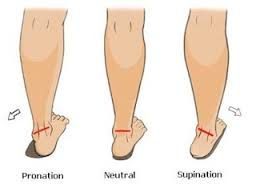
Physiotherapist explains foot pronation & supination
A physiotherapist explains Pronation and supination as movements that occur at the subtalar joint of the foot. The normal biomechanics of the foot are designed to absorb and direct the forces occurring throughout the gait cycle. As the foot is loaded, eversion of the subtalar joint, dorsiflextion of the ankle, and abduction of the forefoot occur. This is the pronation part of the gait cycle. Pronation should not continue past the latter stages of midstance during the gait cycle. At this stage the foot should then supinate in preparation for toe-off. Approximately four degrees of pronation and supination are necessary to enable the foot to propel forward properly. Any increase on this four degrees brings a foot into over-supination or over-pronation.
Pronation – physiotherapist explaination
Pronation of the foot is where the heel and the little toe move away from the center of the body. The foot also dorsiflexes up slightly, the ankle rolling inwards. Pronation is part of the natural movement of the human body. Certain injuries can occur with excessive pronation. Runners with flat feet often tend to overpronate. Over-pronation can contribute to many injuries. These include shin splints, anterior compartment syndrome, patello-femoral pain syndrome, plantar fasciitis, tarsal tunnel syndrome, bunions (hallux valgus), achilles tendonopathies etc. The running shoes of over-pronators often show extra wear on the inner heel and ball of the foot.
Supination – physiotheraist explaination
With supination the heel and also the big toe rotate towards the centre of the body. The foot flexes down and the ankle rolls out. It is the opposite of pronation. A natural amount of supination occurs during the push-off phase of the running gait. This occurs as the heel lifts off the ground and the forefoot and toes are used to propel the body forward. However, excessive supination places a large strain on the muscles and tendons that stabilize the ankle. This can make the oversupinator more prone to ankle sprain or ankle ligament rupture.
With over-supination the forces of impact on the foot are concentrated on a smaller area of the foot (the outside part), and are not distributed as efficiently. In the push-off phase, most of the work is done by the smaller toes on the outside of the foot, rather than the big toe. This places extra stress on the foot. It can lead to conditions such as iliotibial band syndrome, Achilles tendinitis, or plantar fasciitis. Over-supination causes the outer edge of running shoes to wear sooner. In extreme cases, there will also be holes in the uppers where the runner’s foot has broken through. Runners with high arches and tight Achilles tendons/calves tend to be over-supinators.
Orthotics
Properly prescribed foot orthotics can be beneficial in the treatment of over-pronation or over-supination. Physiotherapists usually supply both off the shelf and/or custom made orthotics. We prescribe these only when we really feel they are necessary. Often the much cheaper off the shelf version will do the trick. It is important to get a quality product, prescribed by an experienced practitioner. Sometimes you just have an injury that needs treatment and there is no need for an orthotic. Also high arches or a flat feet do not mean in itself you need orthotics, especially if you are not in pain.